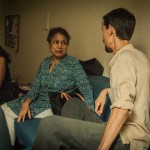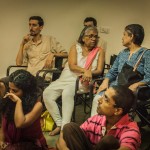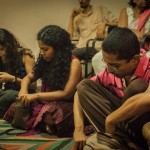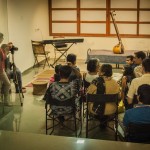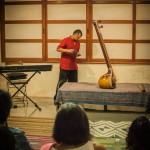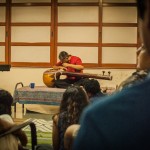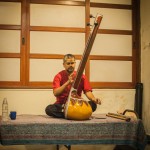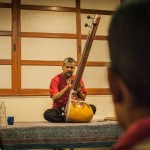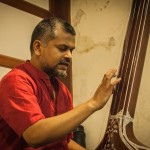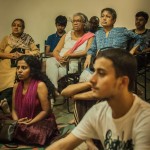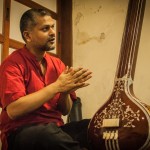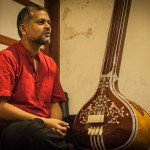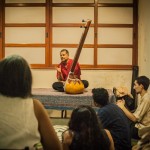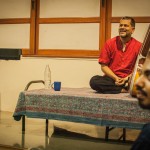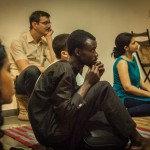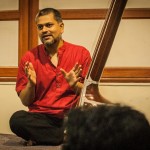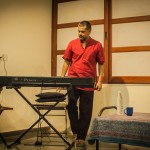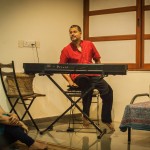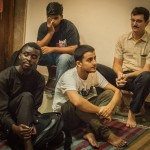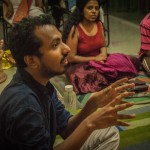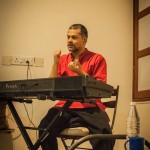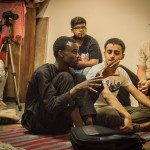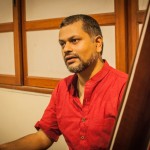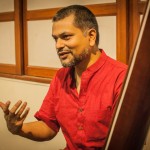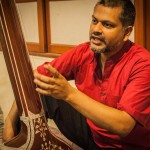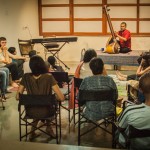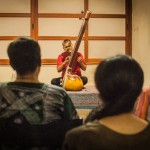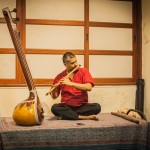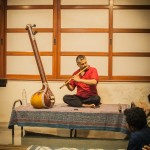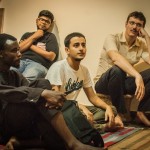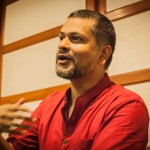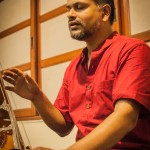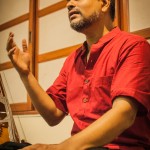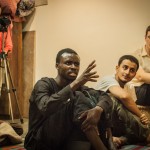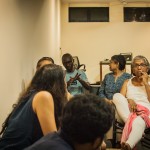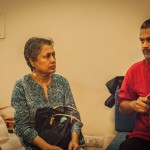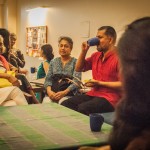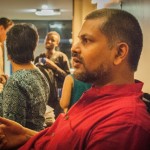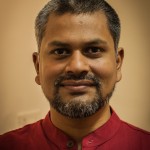
© LILA Foundation

Ashish Dha’s passionate engagement with the world of music became accessible to an eager bunch at the last Kaapi LILA. The muses conspired for an exploratory music appreciation session at Nasheman that day, despite a scary power shut down which resumed less than a minute to the scheduled 5 pm. Delhi temperature soared at 45 Degree Celsius and Nasheman felt like a real nest; in Urdu, Nasheman means a bird’s nest.
It all started with Rachna and Ashish crashing into Nasheman with a truckload of musical equipment. Such a pleasure to witness this! This was in earnest response to the ethos of Kaapi, which forefronts the material and tactile of art practice. So, now we have a Tanpura, Electronic Piano, 3 Bansuris (Indian flutes) of different musical dimensions, and the rest.
Sandeep, the caretaker at Nasheman, our intern Siddhant and I helped Rachna and Ashish set up the performance space. Ashish moved up and down the basement humming and whistling, studying the acoustics, often suddenly freezing at a strategic spot and nodding at Rachna and me for approval and without waiting for our response hastily shifting to another spot intently studying the echoes. This continued for some time until we decided on the lower half of the basement for the evening.
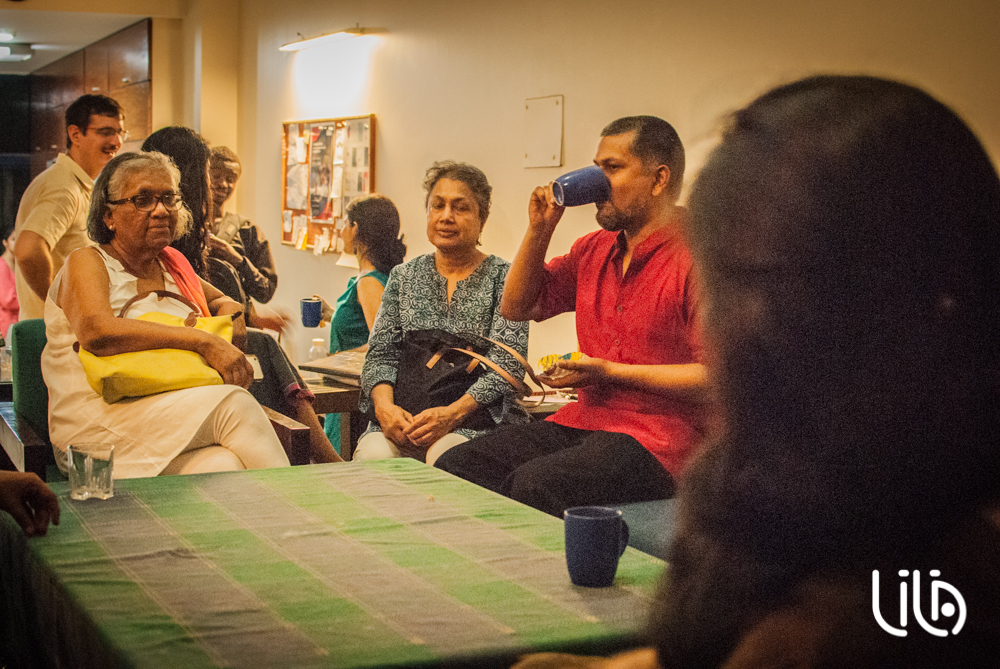
© LILA Foundation
Sandeep set up the spotlights, one tuned to the vocal recital space and the other on to the piano. By the time, our intern Anandi Mehra (video) and Samuel Buchoul (photo) were busy studying the space and picking their corners for the shoot. We were good to go when power failed; every five minutes since, Sandeep kept repeating in a reassuring tone to my worried cries: “Bijlee to vaapas aanahee hei Bhaiya.”
Ashish was on an exploratory mode throughout, opening several windows and leaving none closed. In the introductory remarks he mentioned that it is in order to emphasise the subcontinental character of his music, that he calls it ‘Hindustani Classical Music’ and not ‘Indian Classical Music’. He trains with Ustad Wasifuddin Dagar, Dhrupad musician from the 20th generation of Dagar music family tradition.
Treading from the vocal alap mode, caressing the swaras to the ‘teasing’ of the Tambura, moving on to raag meditations on the piano and perching his lips to the Bansuri and finally melting in a bandish whistle, glimpses of various aspects of his music quest provoked a range of questions.
Hassan Oyedeji, a student of pharmacy from Nigeria, was interested in knowing more about the universality of experiencing a musical sequence. This led to a discussion on how music was experienced and received in different cultures. To the artist’s absolute delight, Oyedeji had remarked that the raag meditation on the piano had a ‘cooling effect’. The raag played was Megh, a monsoon raag! This concern about the effects of music was further explored when Ashish improvised upon his own raag Trishna (Thirst) on the Bansuri and sought responses from the group on what effect it had on each person…
Siddhant Kalra, a guitarist and an undergraduate student of Culture Studies, sought to engage our attention to the history of music appreciation across time, building on Hassan’s remark. Ashish chose to sing a few raag-based Bandishes and demonstrated the colours one raag could take. The musician’s personalised rendering, often upsets the textbook effects or moods.

© LILA Foundation
Junior Bukasa, a Congolese mathematician, enquired about the stretchability of the Tanpura as a musical instrument to accompany other musical genres. This provoked a fascinating phase on thinking with Ashish, not only on the knowledge reserves in the Hindustani musical system but also on specific biases that the tradition was burdened with. Seeking more clarity on this question, we sang the basic swaras of ‘Twinkle Twinkle Little Star’ with the Tanpura creating the musical ambiance. Many of us could not initially recognise the familiar tune as the Hindustani context was colouring our perception. We also saw that harmony was possible here… So where exactly is that thin line which helps us distinguish generic integrity from corruption?
Other concerns that surfaced at the presentation included structural limitations of the piano to lend itself to sliding and microtonal variations germane to the Hindustani tradition (Ashish mentioned Raga pianist Utsav Lal’s practice in this regard), music and physics, the breath and physical dynamics of whistling, attitudes to daily riyaz, the advantages of learning different subjects with the help of music and sound technology at the school level – yet another area which interests Ashish. Estelle Desai, a pianist and a seasoned alto who has performed with the Neemrana Choir and the Capital City Minstrels was interested in discussing the intricacies of tuning system in the Hindustani classical system in relation to the western instruments.
In effect, the evening stirred the varied pursuits of a diverse audience, drawn from the domains of research, design, finance, music, mathematics, law, medicine, painting, architecture and more. Many participants during coffee unanimously nodded to artist Aban Raza’s view that perhaps we should think of a part 2 Kaapi or an extended workshop time with Ashish to explore the sound design and music education aspects of his practice.
We left it at that; open-ended, nourished, humbled and so full of learning possibilities at the doorstep of a dazzling music system…
Satchin Joseph Koshy
Ashish Dha is a researcher, practitioner and student of Hindustani classical music. Having learnt khayaal gaayaki through school and college, he has recently restarted his training under Ustad F. Wasifuddin Dagar. More details here.



